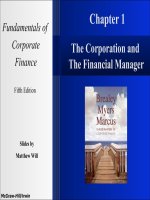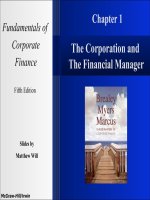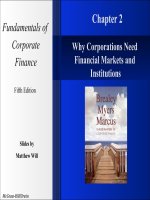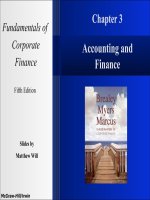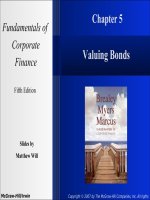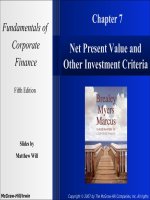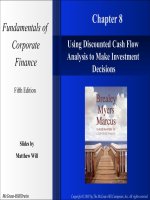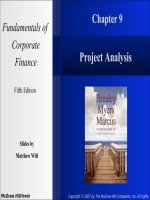Fundamentals of corporate finance 10e ROSS JORDAN chap018
Bạn đang xem bản rút gọn của tài liệu. Xem và tải ngay bản đầy đủ của tài liệu tại đây (1.06 MB, 51 trang )
Chapter
18
Short-Term Finance and
Planning
18-1
McGraw-Hill/Irwin
Copyright © 2013 by The McGraw-Hill Companies, Inc. All rights reserved.
Chapter Outline
• Tracing Cash and Net Working Capital
• The Operating Cycle and the Cash Cycle
• Some Aspects of Short-Term Financial Policy
• The Cash Budget
• A Short-Term Financial Plan
18-2
Chapter Outline
• Tracing Cash and Net Working Capital
• The Operating Cycle and the Cash Cycle
• Some Aspects of Short-Term Financial Policy
• The Cash Budget
• A Short-Term Financial Plan
18-3
Overarching Principles
Much of this chapter is
about timing:
Keep the money you have
as long as you can;
Get the money owed you
as soon as you can.
18-4
Sources and Uses of
Cash
Balance sheet identity (rearranged):
NWC + fixed assets = long-term debt + equity
NWC = cash + other CA – CL
Cash = long-term debt + equity + CL
– CA other than cash – fixed assets
18-5
Sources and Uses of
Cash
Sources of Cash:
Increasing long-term debt, equity, or current liabilities
Decreasing current assets other than cash, or fixed assets
Uses of Cash:
Decreasing long-term debt, equity, or current liabilities
Increasing current assets other than cash, or fixed assets
18-6
Chapter Outline
• Tracing Cash and Net Working Capital
• The Operating Cycle and the Cash Cycle
• Some Aspects of Short-Term Financial Policy
• The Cash Budget
• A Short-Term Financial Plan
18-7
The Operating Cycle
Operating cycle – time between purchasing the
inventory and collecting the cash from sale of the
inventory
Inventory period – time required to purchase and sell
the inventory
18-8
The Operating Cycle
Accounts receivable period – time required to collect
on credit sales
Operating cycle = inventory period + accounts
receivable period
18-9
Cash Cycle
Cash cycle
Amount of time we finance our
inventory
Difference between when we receive
cash from the sale and when we have to
pay for the inventory
18-10
Cash Cycle
Accounts payable period – time
between purchase of inventory and
payment for the inventory
Cash cycle = Operating cycle –
accounts payable period
18-11
Operating and Cash
Cycles
18-12
Example Information
Inventory:
Beginning = 200,000
Ending = 300,000
Accounts Receivable:
Beginning = 160,000
Ending = 200,000
Accounts Payable:
Beginning = 75,000
Ending = 100,000
Net sales = 1,150,000
Cost of Goods sold = 820,000
18-13
Example Solution –
Operating Cycle
Inventory period
Average inventory = (200,000+300,000)/2 = 250,000
Inventory turnover = 820,000 / 250,000 = 3.28 times
Inventory period = 365 / 3.28 = 111 days
Receivables period
Average receivables = (160,000+200,000)/2 = 180,000
Receivables turnover = 1,150,000 / 180,000 = 6.39 times
Receivables period = 365 / 6.39 = 57 days
Operating cycle = 111 + 57 = 168 days
18-14
Example Solution –
Cash Cycle
Payables Period
Average payables = (75,000+100,000)/2 = 87,500
Payables turnover = 820,000 / 87,500 = 9.37 times
Payables period = 365 / 9.37 = 39 days
Cash Cycle = 168 – 39 = 129 days
18-15
Example Solution –
Interpretation
We have to finance our inventory for 129 days
If we want to reduce our financing needs, we need
to look carefully at our receivables and inventory
periods – they both seem extensive.
A comparison to industry averages would help
solidify this assertion.
18-16
Chapter Outline
• Tracing Cash and Net Working Capital
• The Operating Cycle and the Cash Cycle
• Some Aspects of Short-Term Financial Policy
• The Cash Budget
• A Short-Term Financial Plan
18-17
Short-Term Financial
Policy
Size of investments in current assets
Flexible (conservative) policy – maintain a
high ratio of current assets to sales
Restrictive (aggressive) policy – maintain a
low ratio of current assets to sales
18-18
Short-Term Financial
Policy
Financing of current assets
Flexible (conservative) policy – less short-
term debt and more long-term debt
Restrictive (aggressive) policy – more
short-term debt and less long-term debt
18-19
Carrying vs. Shortage
Costs
Managing short-term assets
involves a trade-off between
carrying costs and shortage costs.
Is there an optimal balance
between the two?
18-20
Carrying vs. Shortage
Costs
Carrying costs – increase with increased levels of current
assets, the costs to store and finance the assets
Shortage costs – decrease with increased levels of current
assets
Trading or order costs
Costs related to safety reserves, i.e., lost sales
and customers, and production stoppages
18-21
Temporary vs. Permanent
Assets
Temporary current assets:
Sales or required inventory build-up
may be seasonal
Additional current assets are needed
during the “peak” time
The level of current assets will
decrease as sales occur
18-22
Temporary vs. Permanent
Assets
Permanent current assets:
Firms generally need to carry a
minimum level of current assets at all
times
These assets are considered
“permanent” because the level is
constant, not because the assets aren’t
sold
18-23
Timing of Asset
Requirements
18-24
Choosing the Best Policy
Cash reserves
High cash reserves mean that firms will be less likely to
experience financial distress and are better able to handle
emergencies or take advantage of unexpected opportunities
Cash and marketable securities earn a lower return and are
zero NPV investments
Maturity hedging
Try to match financing maturities with asset maturities
Finance temporary current assets with short-term debt
Finance permanent current assets and fixed assets with long-
term debt and equity
18-25
